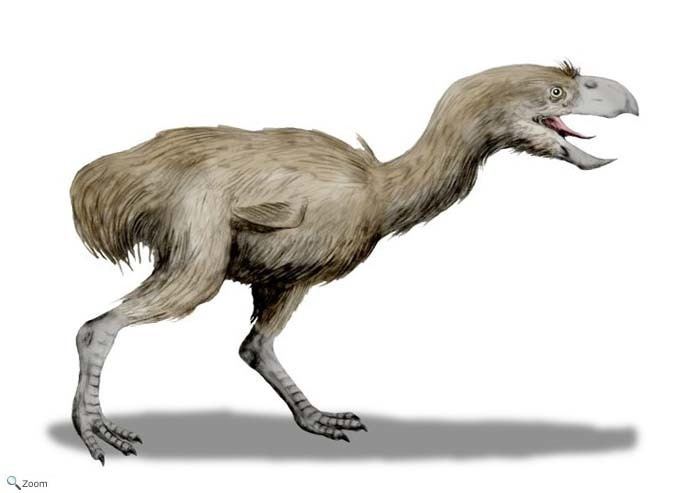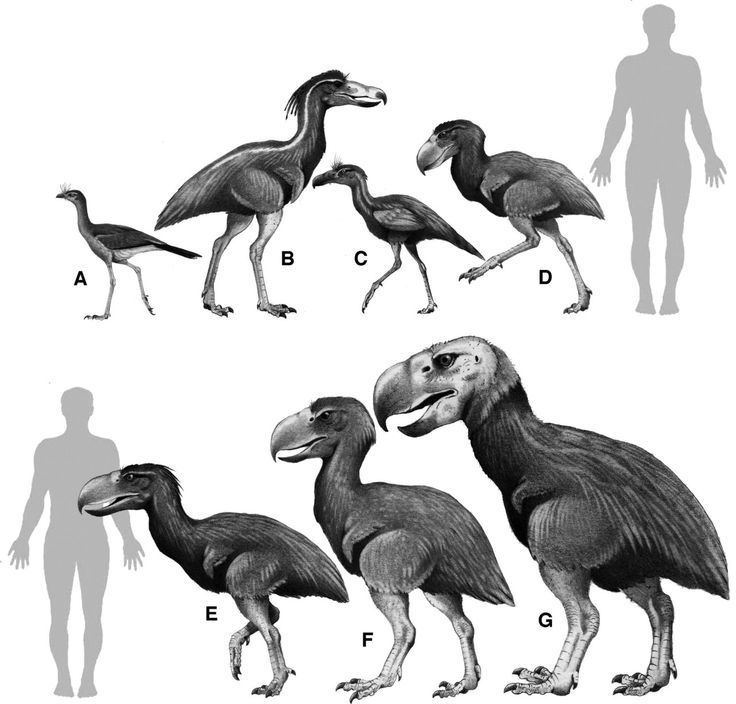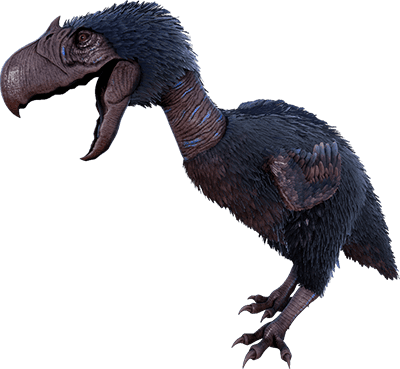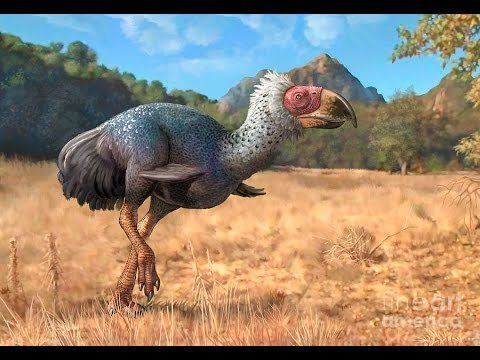Scientific name Phorusrhacidae Phylum Chordata | Higher classification Phorusrhacoidea Rank Family | |
 | ||
Superfamily †PhorusrhacoideaAmeghino, 1889 Lower classifications | ||
Phorusrhacids, colloquially known as terror birds, are an extinct clade of large carnivorous flightless birds (avian-dinosaurs) that were the largest species of apex predators in South America during the Cenozoic era; their temporal range covers from 62 to 1.8 million years (Ma) ago.
Contents
- Reality of myth did dragons exist of phorusrhacidae raptors ice age dragons and terror birds
- Description
- Palaeobiology
- Diet
- Extinction
- Recent skull discoveries
- Classification
- References

They ranged in height from 1–3 metres (3.3–9.8 ft) tall. Their closest modern-day relatives are believed to be the 80 cm-tall seriemas. Titanis walleri, one of the larger species, is also known in North America from Texas and Florida. This makes the phorusrhacids the only known large South American predator to migrate north during the Great American Interchange, which commenced after the Isthmus of Panama land bridge rose about 10 to 15 Ma.

It was once believed that T. walleri became extinct in North America around the time of the arrival of humans, but subsequent datings of Titanis fossils provided no evidence for their survival after 1.8 Ma. Still, reports from Uruguay of new findings dating to 450,000 and 17,000 years ago, would imply that some phorusrhacids survived there until very recently (i.e., until the late Pleistocene); but this claim is debated.

Phorusrhacids may have even made their way into Africa; the genus Lavocatavis was recently discovered in Algeria, but its status as a true phorusrhacid is questioned. A possible European form, Eleutherornis, has also been identified, suggesting that this group had a wider geographical range in the Paleogene.

The closely related bathornithids occupied a similar ecological niche in North America across the Eocene to Miocene; some, like Paracrax, reached similar sizes to the largest phorusrhacids. At least one analysis recovers Bathornis as sister taxa to phorusrhacids, on the basis of shared features in the jaws and coracoid, though this has been seriously contested, as these might have evolved independently for the same carnivorous, flightless lifestyle.
Reality of myth did dragons exist of phorusrhacidae raptors ice age dragons and terror birds
Description
Based on Claudia P. Tambussi, Ricardo de Mendoza, Federico J. Degrange, and Mariana B. Picasso’s work, the phorusrhacid's neck can be divided into three main regions (region 1, region 2, and region 3). In the higher regions of the neck, the phorusrhacid has bifurcate neural spines (BNS), while it has high neural spines in its lower regions. This suggests that the phorusrhacid had a highly flexible and developed neck allowing it to carry its heavy head and strike with terrifying speed and power. Although the phorusrhacid externally looks like it has a short neck, its flexible skeletal neck structure proves that it can expand farther beyond the expected reach and intimidate its prey using its height, allowing it to strike more easily. Once stretched out into its full length in preparation for a downward strike, its developed neck muscles and heavy head can produce enough momentum and power to cause fatal damage to the Terror Bird’s prey.
Kelenken guillermoi, from the Langhian stage of the Miocene epoch, some 15 million years ago, discovered in Patagonia in 2006, represents the largest bird skull yet found. The fossil has been described as being a 71 cm (28 in), nearly intact skull. The beak is roughly 46 cm (18 in) long and curves in a hook shape that resembles an eagle's beak. Most species described as phorusrhacid birds were smaller, 60–90 cm (2.0–3.0 ft) tall, but the new fossil belongs to a bird that probably stood about 3 m (9.8 ft) tall. Scientists theorize that the large terror birds were extremely nimble and quick runners, able to reach speeds of 48 km/h (30 mph). Examination of Phorusrhacid habitats also indicates that phorusrhacids may have presented intense competition to predatory marsupial sparassodonts such as borhyaenids and thylacosmilids, causing the mammalian predators to choose forested habitats to avoid the more successful and aggressive avian predators on the open plains.
Palaeobiology
Most phorusrhacids were very fast runners. All members possessed a large, sharp beak, a powerful neck and sharp talons. However, even with these attributes, the phorusrhacids are often assumed to have preyed on relatively small animals (about the size of a rabbit) that could be dispatched with a minimum of struggle. This is due to the fact that with the phorusrhacids' beak proportions, the jaw could not generate a great deal of bite force with which to kill the prey. This is disputable as many big-game hunting predators such as Smilodon, great white sharks and Allosaurus have weaker bite forces and often laterally weak skulls as an adaptations towards, not away from, killing large prey, relying instead on the presence of a cutting edge, a wide gape made possible by the reduction of jaw musculature, and the driving force of the body or neck. Since phorusrhacids share many of the same adaptations, such as a large, laterally flattened skull with a sharp-edged beak and powerful neck musculature, it is possible that they were specialized predators of relatively large prey.
The bones of the beak were tightly fused together, making the beak more resilient to force from the front to back direction, thus suggesting that it could cause a great amount of harm through pecking but not by side-to-side head movements like shaking prey. Generally speaking, it is thought that a terror bird would use its feet to injure prey by kicking it, and to hold the prey down and dispatch by pecking at it with its large beak. Larger prey may also have been attacked by pecking and kicking, or by using the beak as a blade to strike at or slash vital organs.
It has been recently shown that at least some phorusrhacids like Andalgalornis, while very fast runners in a straight line, were poor at tight turns at speed, which contradicts the idea of phorusrhacids being agile predators of small prey.
Diet
All phorusrhacids are thought to have been carnivorous. The strong downwards curve from the tip of this beak suggests that it ripped the flesh from the body of other animals. Many extant bird species with this feature are carnivorous. CT scans performed on the skull of a phorusrhacid reveal that the species would not have been able to shake its prey side to side, but rather exert significant downward force. The anatomy of the typical phorusrhacid skull shows that it can handle this form of stress the best. This downward force would have allowed the phorusrhacid to shatter bones more easily, stunning its prey and making it easier to swallow whole. Some researchers think that the phorusrhacids closest relative, the seriema, acts very much like a phorusrhacid would have; picking up the prey and throwing them down then picking at them. If the prey was too large to swallow whole, the curved tip of the beak allowed the bird to pick at the prey and rip apart flesh, all using its very strong neck structure. They may have also used their claws to tear apart carcasses as well as helping them tear flesh.
Extinction
From 27 million years to 2.5 million years ago, there was an increase in the phorusrhacid population size in South America, suggesting that, in that time frame, the various species flourished as predators in the savannah environment.
The traditional view of phorusrhacid extinction is that, as the Isthmus of Panama emerged, 2.5 million years ago, carnivorous dogs, bears, and cats from North America were able to cross into South America, increasing competition. As the population of phorusrhacids gradually decreased, this suggests that competition with other predators was a major influence on Phorusrhacidae extinction.
However, the role of competitive displacement in the demise of phorusrhacids, and in other South American predator lineages like sparrasodonts, is now being questioned. It appears that the Great American Interchange was a much more gradual process than earlier thought, beginning well back over ten million years ago in the Miocene, when placental carnivorans like Cyonasua first reached South America. The timing of the predator extinctions also does not correlate well with the arrival of large carnivores like canids or sabretooths, with the vast majority of phorusrhacids, as well as all sparassodonts, dying out well before the arrival of larger placental carnivores. Bathornithids, which were similar in ecology and are likely close relatives of phorusrhacids, existed entirely within North America alongside large placental predators, including carnivorans like nimravids, providing a precedent for large, flightless predatory birds successfully thriving alongside placental carnivores for a long period of time. In addition, phorusrhacids expanded northward into North America during the Interchange and coexisted for several million years with large canids and big cats like Xenosmilus, suggesting that they were capable of successfully establishing themselves in the face of placental competition.
Some researchers believe that the Phorusrhacidae's extinction started at the beginning of the Pleistocene, 2.5 million years ago. South America was also home to other large carnivorous animals, including the sebecid crocodylomorphs, giant snakes and predatory relatives of marsupials called sparassodonts, all of which were direct competitors with the phorusrhacids. This meant even more competition for the phorusrhacids. However, competition from native predators as a factor in their extinction is debatable as Phorusrhacids themselves seemed to be more aggressive than many of their competitors, to the point where some native predators like the sparassodonts such as Thylacosmilus evolved to hunt in forested habitats to avoid them. Overall, it is far more likely that phorusracids died out due to environmental change rather than competition with other predators.
There were some suggestions that phorusracids, like the majority of Pleistocene megafauna, were killed off by human activity such as hunting or habitat change. This idea is no longer considered valid, as improved dating on Titanis specimens show that the last phorusracids went extinct over one million years before humans evolved.
Recent skull discoveries
In the past, these birds were thought to have high beaks, round orbits, and vaulted braincases though there was never enough empirical evidence to support this. However, new fossils have been discovered in Cormollo, Argentina. These skulls reveal that the terror bird has a triangular dorsal view, a rostrum that is hooked and more than half the length of the actual skull, and a more compact caudal portion. The external nares and antorbital fenestras (areas found in the nose) were found to be more square than triangular. These all contribute to a skull that is more rectangular in view rather than triangular. The structure of the fossils also suggest that these birds may have been swifter than originally thought.
A skull from a smaller subspecies of this bird was also found recently. With this fossil, it was found that the internal structure of the beak is hollow and reinforced with thin-walled trabeculaa. There is also an absence of both zona flexoria palatina and zona flexoria arcus jugalis, which are key features that relate to the evolution of cranial akinesis. The discovery of this skull allows for the establishment of primary osteological homologies, which are useful in comparative anatomy, functional morphology, and phylogenetic studies.
Classification
The etymology of the name Phorusrhacidae is based on the type genus Phorusrhacos. When first described by Florentino Ameghino in 1887, the etymology of Phorusrhacos was not given. Current thinking is that the name is derived from a combination of the Greek words "phoros", which means bearer or bearing, and "rhacos", which translates to wrinkles, scars or rents. Researchers have compared Phorusrhacidae with the living families of Cariamidae and Sagittaridae, but their differences in body mass are too drastic, and thus, one cannot overly depend on these living families for answers.
Following the revision by Alvarenga and Höfling (2003), there are now 5 subfamilies, containing 14 genera and 18 species: These species were the product of adaptive radiation.
Family Phorusrhacidae
Alvarenga and Höfling did not include the Ameghinornithidae from Europe in the phorusrhacoids; these have meanwhile turned out to be more basal members of Cariamae. Though traditionally considered as members of the Gruiformes, based on both morphological and genetic studies (the latter being based on the seriema) they may belong to a separate group of birds (the Cariamae) and their closest living relatives, according to the last nuclear studies, are a clade conformed by Falconidae, Psittaciformes and Passeriformes
